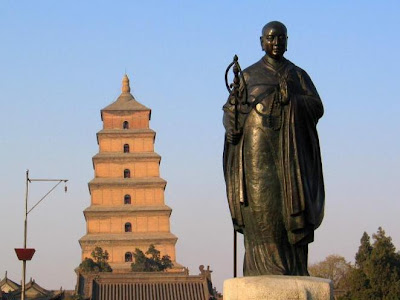The Big Wild Goose Pagoda is located in the southern suburb of Xi’an, about 2 km from the downtown and is one of the symbolic structures of Xi’an. It was built in 653 B.C. and has been well-preserved as a holy place for Buddhists. Standing in the Da Ci'en Temple complex, it attracts every year numerous visitors for its religious fame, the simple but appealing construction style, and the new square in front of the temple.
Big Wild Goose Pagoda is 64 meters high, a brick and wood structure. In the Ming Dynasty (1386~1644 AD), a huge 8.0 earthquake struck in Huaxian County, Shaanxi Province. The earthquake killed over 830,000 people and reached 90 counties in 5 provinces, with more than ninety percent of buildings in these areas destroyed. Big Wild Goose Pagoda survived with only moderate damage to the top and still stands today as a potent symbol of Xian.
The original Big Wild Goose Pagoda was built during the reign of Emperor Gaozong of Tang (r. 649-683), then standing at a height of 54 m (177 ft). However, this construction of rammed earth with a stone exterior facade eventually collapsed five decades later. The ruling Empress Wu Zetian had the pagoda rebuilt and added five new stories by the year 704 AD. However, a massive earthquake in 1556 heavily damaged the pagoda and reduced it by three stories, to its current height of seven stories. The entire structure leans very perceptibly (several degrees) to the west. Its related structure, the 8th century Small Wild Goose Pagoda in Xi'an, only suffered minor damage in the 1556 earthquake (still unrepaired to this day). The Giant Wild Goose Pagoda was extensively repaired during the Ming Dynasty (1368–1644) and renovated again in 1964. The pagoda currently stands at a height of 64 m (210 ft) tall and from the top it offers views over the current city of Xi'an.
Da Ci’en Temple was originally built in 589 AD. It was not until the Zhenguan period of the Tang Dynasty, in 648 AD, that Li Zhi (the third emperor of Tang Dynasty) ordered the reparation of the temple in memory of his mother Empress Wende. The temple was later renamed Da Ci’en Si. The Tang Regime appointed the widely renowned Master Xuan Zang as the head of the temple.
The temple was destroyed by war during the downfall of the Tang Dynasty and the halls and rooms we see today were actually built in Ming Dynasty. Da Ci'en Temple is the home of Big Wild Goose Pagoda. In 648, to commemorate the dead virtuous queen, royalty ordered the building of a temple named 'Ci'en' (Mercy and Kindness), for which the status and scale far exceeded all others. Today, with an area of 32,314 square meters (38,648.5 square yards), one seventh of the original area, it still retains its grandeur.
Big Wild Goose Pagoda It was molded in 1548 in the Ming Dynasty (1368-1644). Along the central axis are arranged the Hall of Mahavira, Sermon Hall, Big Wild Goose Pagoda, and the Hall of Xuanzang Sanzang. In the Hall of Mahavira are three carved statues of Sakyamuni, and 18 arhats as well as Xuanzang. The Sermon Hall is where Buddhist disciples would listen to a sermon. A bronze statue of Amitabha is dedicated and a Buddha statue is collected by Xuanzang as oblation. The Hall of Xuanzang Sanzang is north of Big Wild Goose Pagoda. In this hall are Xuanzang's relic and a bronze statue of a seated Xuanzang.















0 comments:
Post a Comment